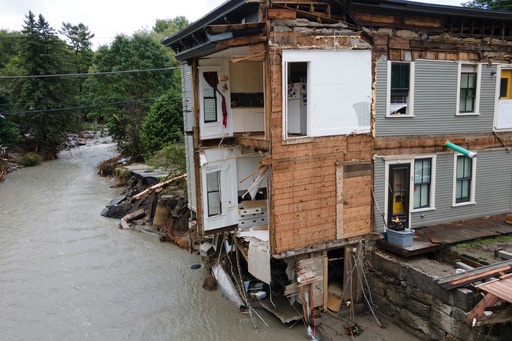Vermont seeks federal damage assessment for floods caused by Hurricane Beryl’s remnants

FILE - An overwhelmed residents surveys the damage following flooding caused by the remnants of Hurricane Beryl, July 11, 2024, in Plainfield, Vt. Vermont is seeking a federal assessment to determine whether last week’s flooding, which damaged homes, knocked out bridges and washed out roads, qualifies for a federal disaster declaration and aid. (AP Photo/Dmitry Belyakov, file)[ASSOCIATED PRESS/Dmitry Belyakov]
PLAINFIELD, Vt. (AP) — Vermont is seeking an assessment to determine whether last week’s flooding, which damaged homes, knocked down bridges and washed out roads, qualifies for a federal disaster declaration and aid.
The flooding from the remnants of Hurricane Beryl happened a year after the state experienced catastrophic flooding that left some victims still awaiting home buyouts or repairs.
“We know this storm has done tremendous damage in many communities, and those impacted will need help to recover,” Gov. Phil Scott said in a statement Saturday. “That’s why it’s so critical for Vermonters to report their damage to help us demonstrate the need for these federal resources.”
Two people were killed by the flooding, including a motorist in Lyndonville and a man who was riding an all-terrain vehicle in Peacham, authorities said.
Some of the hardest-hit riverside communities were Barre, Hardwick, Lyndonville, Moretown and Plainfield, but the estimated $15 million in damage to roads and other public infrastructure was more widespread. Damage assessments will be done in eight of Vermont’s 14 counties. A public assistance disaster declaration would provide 75% reimbursement to communities for responding to and repairing public infrastructure damaged by the storm, the governor said.
The Federal Emergency Management Agency must verify at least $1.1 million in response and public infrastructure recovery costs for the state to qualify for a major disaster declaration, according to Scott. For counties to qualify, they must show damages of $4.60 per capita, Scott’s office said.
An individual assistance declaration would give some financial assistance to homeowners and renters for property losses, the governor said. They are encouraged to report property losses by calling 211 or visiting www.vermont211.org.
Even though Vermont is an inland state, it’s suffered damage from tropical storm systems. In 2011, Tropical Storm Irene dumped 11 inches (28 centimeters) of rain on parts of the state in 24 hours. The storm killed six in the state, washed homes off their foundations and damaged or destroyed more than 200 bridges and 500 miles (800 kilometers) of highway.
In May, Vermont became the first state to enact a law requiring fossil fuel companies to pay a share of the damage caused by extreme weather fanned by climate change. But officials acknowledged last week that collecting any money will depend on litigation against a much-better-resourced oil industry.
Copyright 2024 The Associated Press. All rights reserved. This material may not be published, broadcast, rewritten or redistributed without permission.
